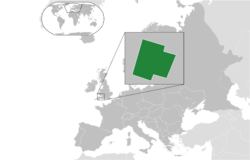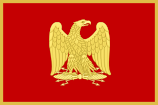Ornessian People's Republic
Ornessian People's Republic République populaire ornessienne | |
|---|---|
| Motto: 'La fierté est la force' Pride is strength | |
| Anthem: "Hymn of the Stags" | |
 | |
| Capital and largest city | Alexanderville |
| Official languages | English French |
| Demonym(s) | Saruit |
| Government | Unitary parliamentary semi-constitutional monarchy |
| Rafe Hargreaves | |
| Connor Simonetti | |
| Legislature | Supreme Nortonian Conference |
| Independence from the United Kingdom | |
• Independence declared | 1 October 2024 |
| Area | |
• Total | 0.0445 km2 (0.0172 sq mi) |
| Population | |
• 2024 census | 37 |
| Currency | Saruit Guilder (NTL) |
| Time zone | BST |
| Driving side | left |
| Calling code | +44 |
| IMSO 1 code | NRT |
The Ornessian People's Republic more commonly known as Ornesse, is a self-declared independent state with minimal international recognition, and is referred to exclusively as a micronation by external observers. Sarum sits at the bottom of Ham Hill National Park and is surrounded by the United Kingdom. The total land area of the nation, including all the provinces is approximately 0.0445km2. The capital and largest city of the nation is Alexanderville. The nation consists of multiple ethnic groups from all over the world, and is heavily influenced by a blend of English and French culture.
The nation was founded and formally established on 1 October 2024, as a unitary parliamentary semi-constitutional monarchy. The de jure currency is the Saruit Guilder, however, the British pound is more commonly used. The two official languages are English and French, with English being spoken by 82.42% of the population.
Etymology
The State of Norton takes its name from the village of Norton-Sub-Hamdon in the macronation of the United Kingdom. The majority of the houses and cottages in the village are made from the local stone, hamstone, which is taken from the nearby Ham Hill, from whence the village gets its name. In fact, Norton-Sub-Hamdon means "north below the hill farm".
Official Names
- Republic of West Norton (6-8 July 2021)
- State of Norton (8 July 2021 - 30 May 2022)
- Kingdom of Norton (30 May 2022 – 29 July 2023)
- Nortonian Republic (29 July 2023 - 2 November 2023)
- State of Norton (2 November 2023 - present)
The IMSO 1 code for Norton is NRT.
History
Early History
Foundation
The State of Norton was founded on 6 July 2021, as the Republic of West Norton by Rafe Burfield and Ben Sheldon with the claiming of Sarum. The declaration of independence was signed at Monclair House by the newly installed President, and is commonly referred to as the Monclair Accords. The nation adopted its current name on the 8 July 2021.
The Magna Coetus Incrementum
The Magna Coetus Incrementum (latin for "The Great Coalition") was a period of rapid growth within Norton, which began on 8 July 2021. The period began with the accumulation of a range of territories directly to the north-east of the original 1-acre property. It is believed that the three province's (Regionem Capitis, Arbour and Tyrian) venture into Norton was prompted by a need to further solidify their position at the bottom of the Ham Hill stronghold, and gain control over a tributary of the River Parrett. Through an Executive Order, President Rafe Burfield authorised the transition of the Nortonian Federal Government from the original province of Sarum to the newly incorporated province of Regionem Capitis, simultaneously granting Mill Green City capital city status.
Politics and government
This article needs to be updated. |


The State of Norton is a unitary one-party presidential republic, with the President as head of state and head of government. He is also First Secretary of the Peoples National Party of Norton (PDNP). The President is also commander-in-chief of the Nortonian People’s Army. The executive branch is led by the President, who appoints the cabinet. The Supreme Nortonian Conference is the legislature and highest organ of state power. In theory the legislature is elected by additional members system. In reality the First Secretary of the PDNP appoints members.
- Ministry of Foreign Affairs
- Ministry of the Interior, Labour and National Security
- Ministry of Defence
- Ministry of the Treasury and Fiscal Stability
- Ministry of Justice and Constitutional Affairs
- Ministry of Health, Education and Social Services
- Ministry of Commerce, Trade and Transportation.
- Ministry of Energy and Environmental Services
- Ministry of Housing and Regeneration
- Ministry of Citizenship and Cultural Affairs
Each of these ministries are led by a Minister, appointed by the President.

Local government
Norton is divided into six regions.
| Duchy | Flag | Capital | Ruling party |
|---|---|---|---|
| Regionem Capitis | Mill Green City
(Also National Capital) |
National Conservatives | |
| Tyrian | Lindenrouge | National Conservatives | |
| Arbour | Gantrick | Liberal Agrarian Party | |
| Sarum | Magdalen | National Conservatives | |
| Montagne | Lavigne | National Conservatives | |
| Waldflache | Alexandertown | Liberal Agrarian Party |
Law and Order
As the nation adheres to the Westminster model of Parliamentary democracy (the Prime Minister and ministers are members of the Estates General), there exists the three pillars of democracy - executive, legislature and judiciary. The judiciary stands as an independent branch of the system with the Supreme Court of the Kingdom of Norton being the supreme judicial body of Norton and the highest court in the nation. It is the most senior constitutional court and has the power of judicial review. The Chief Justice of Norton is the head and chief judge of the court.

The Attorney General is yet another judicial officer who serves as the government's chief legal adviser and leads the Department of Justice. The Nortonian Police Force is the national police force of Norton. It is subdivided into province divisions. The Inspector-General serves as the head of the force, while district commissioners are appointed to administer the provincial divisions.

Foreign relations and alliances
Norton has established and maintains diplomatic relations with many other nations from all over the world. All matters related to diplomacy are administered by the Ministry of Foreign Affairs. Norton utilises a two-tier diplomatic relation system, the lesser Treaty of Mutual Recognition and Non-Aggression and the higher Treaty of Friendship and Amicable Co-operation. This treaty recognises a micronation as serious allies and a long time partner in the micronational world.
The Kingdom of Norton is committed to ensuring its foreign policy remains as neutral as possible, and to solve conflicts and disputes diplomatically. Likewise, Norton strongly opposes fictional micronations and micronations that only operate online. Norton is a signatory of a plethora of micronational conventions and strictly adheres to their terms and conditions while maintaining diplomatic relations.

The Kingdom of Norton was a founding member of the Alliance of Unified Democratic Independent Micronations (AUDIMN) alongside the Empire of Muskratia, with then-President Burfield serving as the only Chairman of the alliance from August to September 2021. Likewise, Norton and the Sovereign Municipality of Ameristralia signed the Citadel Accords, a treaty allowing free movement of citizens, military and economic cooperation and the establishment of diplomatic embassies.
The Kingdom of Norton currently maintains a variety of wide ranging diplomatic and bilateral relations with fellow micronations (some are listed below).
Military


The Royal Nortonian Armed Forces is the sole military organisation of the Kingdom of Norton. Due to the passive foreign policy of Norton, the main objective of the armed forces is to ensure and maintain the territorial integrity and national security of the nation. It comprises of three services - the Nortonian Land Forces, the Nortonian Navy and the Nortonian Air Forces.
The Armed Forces are led by the King in his capacity as the Commander-in-chief. The forces are under the jurisdiction of the Ministry of Defence. The Chief of the Defence Staff is the commanding officer of the combined services and is a rank held by a Field Marshal officer of any of the three branches of the armed forces. The three branches of the forces are commanded individually by a 4-star officer from their respective service. Ducal monarchs are appointed to the rank of Lieutenant General if they enlist in the Armed Forces.
National symbols
 Kingdom of Norton |
|
| Name | National flag |
|---|---|
| Use | Civil flag |
| Proportion | 3:5 |
| Adopted | 6 July 2021 |
| Design | A red field charged with a gold Nortonian eagle,surrounded by a gold border (representing sovereignty and territorial integrity). |
| Designed by | Alexander I |
The national symbols of Norton are things which are emblematic, representative or otherwise characteristic of the Kingdom of Norton or Nortonian culture. Some are established, official symbols, including the flag and arms of Norton, whilst some are governmentally-named symbols, such as the national flower and animal. Other symbols may not hold any formal official status, but are likewise recognised at a national or even intermicronational level. The symbols were adopted at various stages in the history of Norton, and subsequently various rules and regulations governing their definition or use exist in accordance with the Nortonian Institute of Heraldry.
| Coat of arms of the State of Norton | |
|---|---|
 | |
| Versions | |
 Royal Coat of Arms of the Kingdom of Norton (HM Government) | |
| Details | |
| Armiger | Alexander (as King of the Nortonians) |
| Adopted | 2021 |
| Crest | A golden helmet with a Nortonian Crown with a backdrop of eight spiked Nortonian Standards. |
| Torse | Crimson mantle, lined with ermine, decorated with golden bees. |
| Escutcheon | A nortonian eagle upon a gules coloured escutcheon. |
| Supporters | Two angels bearing national standards. |
| Motto | Labor Omnia Vincit (Work conquers all) |
| Orders | Order of the Golden Eagle |
| Symbol | Name | Image |
|---|---|---|
| National Flag | Flag of the Saruit Republic | 
|
| National Coat of Arms | National Emblem of the Saruit Republic | 
|
| National motto | Deus et Rex vult illud
"God and King wills it" |

|
| National anthem | Norton, my Kingdom
(Hajibeyov,1920) |
|
| National cockade | National cockade of the Saruit Republic | 
|
| National colours | Red and Gold | 
|
| National animal | Golden Eagle | 
|
| National flower | Camellia | 
|
Geography
The Kingdom of Norton's territory is located in the village of Norton-Sub-Hamdon, Somerset, enclaved beneath the Ham Hill National Park. Surrounded by the rolling green hills of the county, the nation enjoys a wide range of flora and fauna. The majority of the provinces lie in the plains with a wide variety of trees, plants and shrubs. The Kingdom of Norton spans over the time zone of GMT+1. The topography of Norton is diverse and comprises of hills, woodland and plains. As the nation is situated on the banks of the river Parret, the main sources of water in the nation are from the river.









